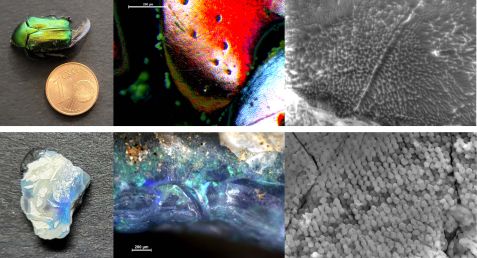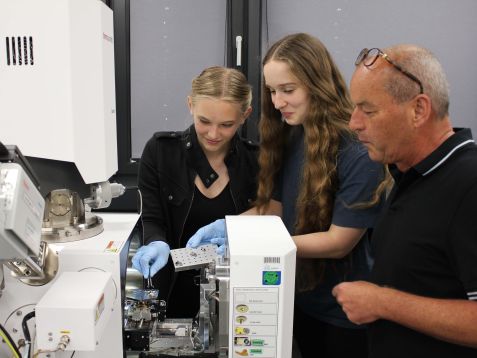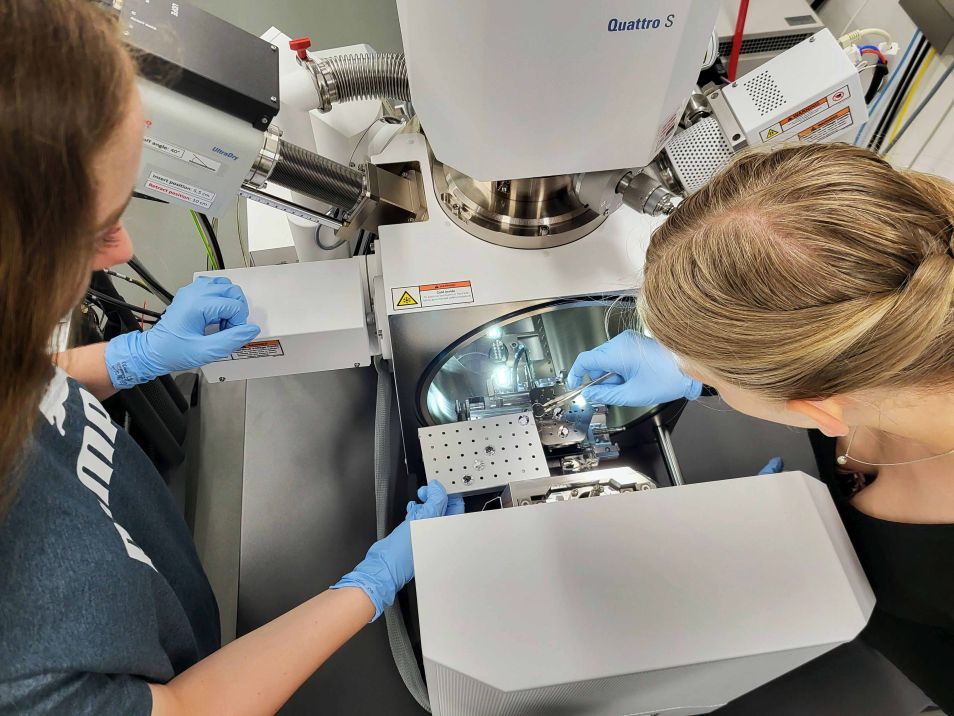MLZ is a cooperation between:
 > Technische Universität München
> Technische Universität München > Helmholtz-Zentrum Hereon
> Helmholtz-Zentrum Hereon
 > Forschungszentrum Jülich
> Forschungszentrum Jülich
MLZ is a member of:
 > LENS
> LENS > ERF-AISBL
> ERF-AISBL
MLZ on social media:

MLZ (eng)
Lichtenbergstr.1
85748 Garching
30.12.2023
The Sparkle of Opals – an internship in the Materials Science Laboratory
For many years, pupils have been completing internships at the MLZ and taking a first look into the engine room of science with their own research. This year, two physics-interested interns spent a week studying the color formation of iridescent opals in the Materials Science Laboratory.
If you take a closer look at an opal and turn it slightly in your hand, you can observe a fascinating phenomenon: The mineral reveals an iridescent play of different colors in the light. The iridescence excludes a mineral dye, so how can this effect arise? Rahel Stiehler from Großhelfendorf and Anna Keppler from Vagen have tackled this question.
Structure makes the colors
“The mechanism of the iridescent colors in the opal is the same as that for the play of colors on the shell of a rose beetle,” explains Rahel Stiehler, pointing with her index finger to a small transparent plastic jar containing an iridescent green beetle. Anna Keppler stands beside her, adding, “The colors are created by the structure, not by any dyes.” They sit at the Jülich Center for Neutron Science (JCNS) electron microscope at the MLZ.
After just one day, the two routinely control the device dominating the room to examine the surface of an opal. A uniform pattern of small spheres appears on the screen. The display shows a magnification of 50,000 times.
From school straight into research?
But if you think the two are scientists at the FRM II, that’s not (yet?) the case. Anna and Rahel are students in the 10th grade at Bruckmühl High School who completed a one-week internship at the Materials Science Lab of the Heinz Maier-Leibnitz Zentrum (MLZ) in Garching.
Their enthusiasm for physics is nothing new, and the two are already familiar with the Garching research campus. They attend the Physics Plus course at school, which has already taken them on excursions to the Max Planck Institutes for Plasma Physics and Quantum Optics and the European Southern Observatory.

A journey from the visible world to the microscopic. The shell of the flower chafer (above) gets its sparkle from evenly arranged ridges that cover its surface (50,000x magnification). The opal from Australia (bottom) consists of densely packed, natural glass beads (20,000x magnification).
Well supervised by an experienced scientist
At the MLZ, the students are supervised by Armin Kriele from the Helmholtz-Zentrum Hereon, who has had numerous interns in his laboratory over the years. “You can tell that Anna and Rahel are very motivated and already have a bit of prior knowledge. That also makes it easier for me,” says Kriele. Before the internship started, Armin Kriele sent the interns student-friendly but detailed training material in which he explained how the electron microscope works and the scientific starting point – heavy reading, in other words. But unlike many physics students before their laboratory practicals, the pupils actually read the material.
Tough workload
This is good because Armin Kriele expects a lot from his interns: “It’s a tough workload. You probably don’t have to concentrate at school for such a long time.”
However, it is crucial to carry out each work step consciously, document the results well, and then compare them with findings from the literature as a “reality check” – good scientific practice. “The two of them should learn how to work scientifically and not be afraid of complex scientific equipment,” says Armin Kriele, describing his objective.
Nevertheless, the laboratory was a new environment for Rahel and Anna. “I didn’t think we would be allowed to operate such an expensive piece of equipment on our own,” Anna reveals and laughs. “Even knowing which is the right adhesive tape to stick samples to is a science in itself.”

Armin Kriele (right) has offered internships for interested high school students for several years, here at the scanning elelectron microscope of the materials science lab. © FRM II / TUM
Natural play of colors
Anna and Rahel have discovered that opals consist of many small silicon dioxide spheres (SiO2) – i.e., colorless glass. In the areas of the opal that shimmer with color, these beads are the same size and are closely and regularly arranged. They, therefore, form a giant crystal lattice. Multicolored light is reflected and scattered from this lattice at different angles, which is why the opals are so iridescent. On the other hand, the milky areas show a much more disordered structure of the spheres. This is the explanation behind cloudy milk opals.
Opals made by themselves
The trainees tested their hypotheses by analyzing both commercially available and homemade artificial opals. They applied a suspension of SiO2 beads to a microscope slide and left it to dry for 24 hours. An ordered crystal structure was visible under the microscope.
Anna and Rahel summarize their results: “The size and arrangement of these structures and the incidence of light determine the color effect. However, the origin of the regular arrangement of opal beads in nature is still unclear.”
“Learned more than at school”
A few questions remain, but perhaps Anna and Rahel will be able to help answer them one day? In any case, the internship has already encouraged them to study science: “We’ve learned so much, definitely more than at school.”
Armin Kriele is also very satisfied. “Anna and Rahel challenged me a bit with some of their detailed questions.”
When asked for their final verdict on the internship in the materials science lab, the interns agreed: “I can’t even put into words how great it was.”
- Not all sand is the same: an internship at the MLZ
- Shooting stars from the gutter
- Laboratory internship between predators and ruminants
- Is the DM really harder than the euro? A materials science study of DM, pfennig, euro and cent coins.
- Are the shells of land and sea mussels and snails made of the same material?
- Where do the many different pebbles in the Isar come from? Examination of Isar pebbles using microscopy and X-ray diffraction.

MLZ is a cooperation between:
 > Technische Universität München
> Technische Universität München > Helmholtz-Zentrum Hereon
> Helmholtz-Zentrum Hereon
 > Forschungszentrum Jülich
> Forschungszentrum Jülich
MLZ is a member of:
 > LENS
> LENS > ERF-AISBL
> ERF-AISBL
MLZ on social media:




